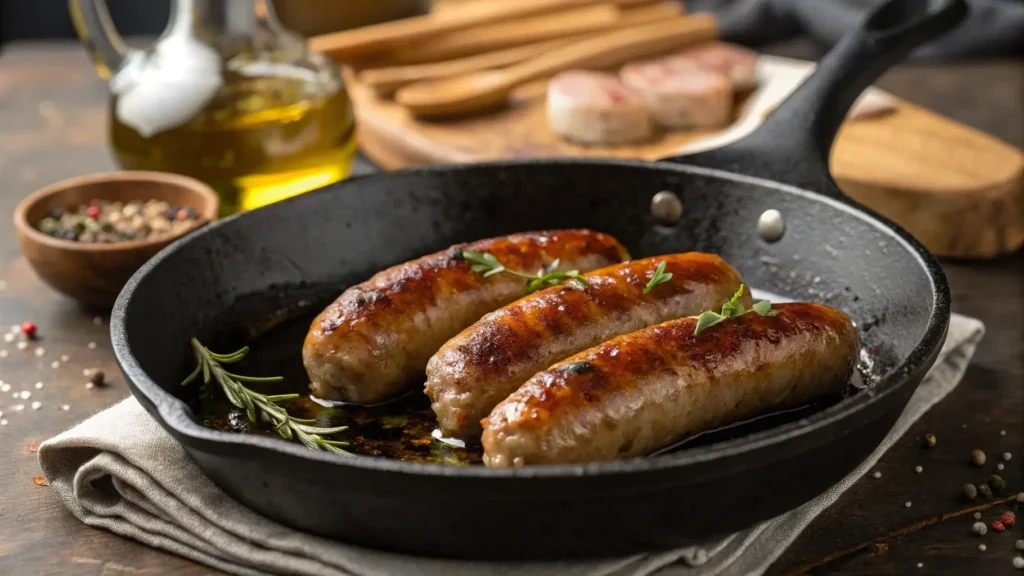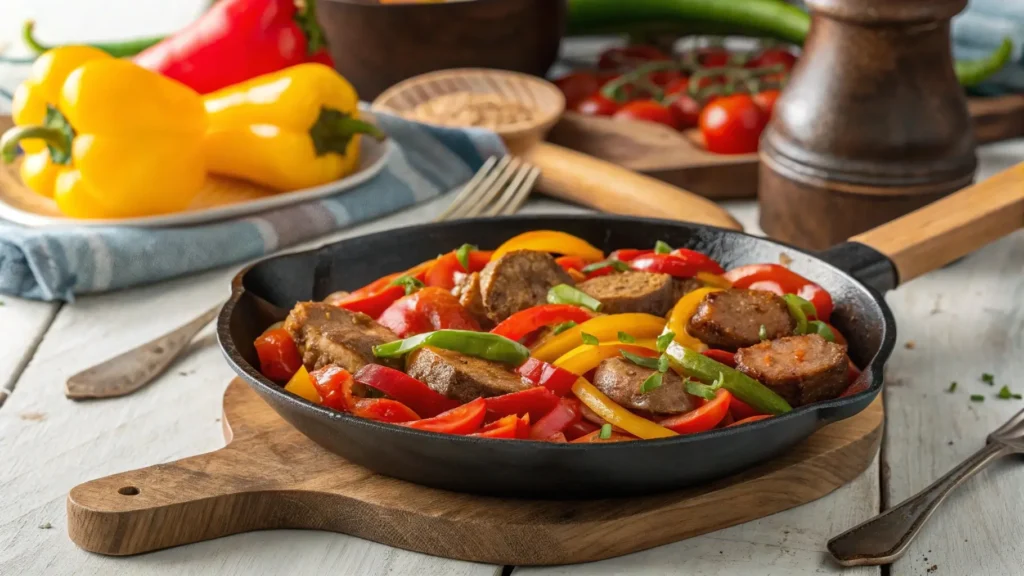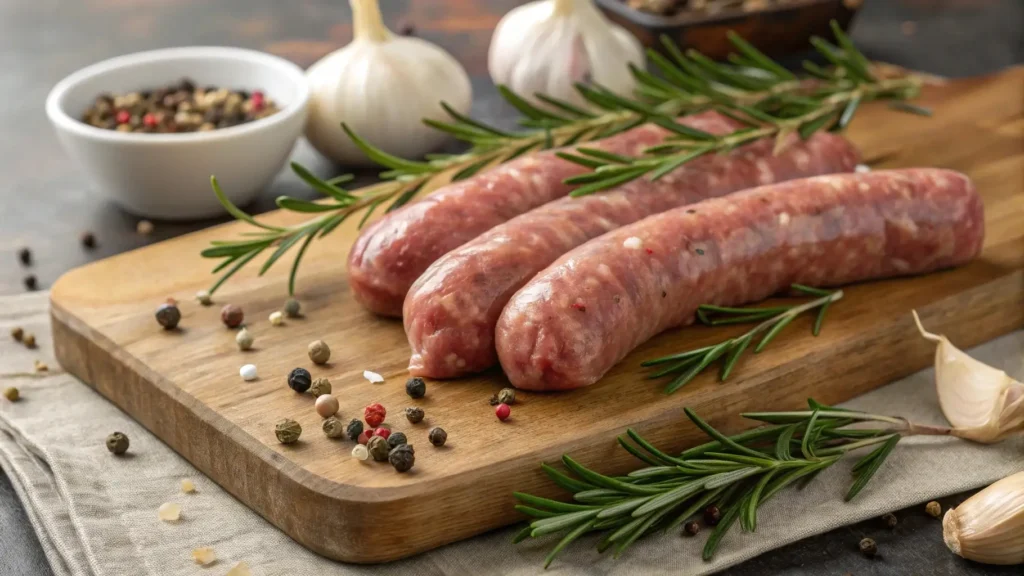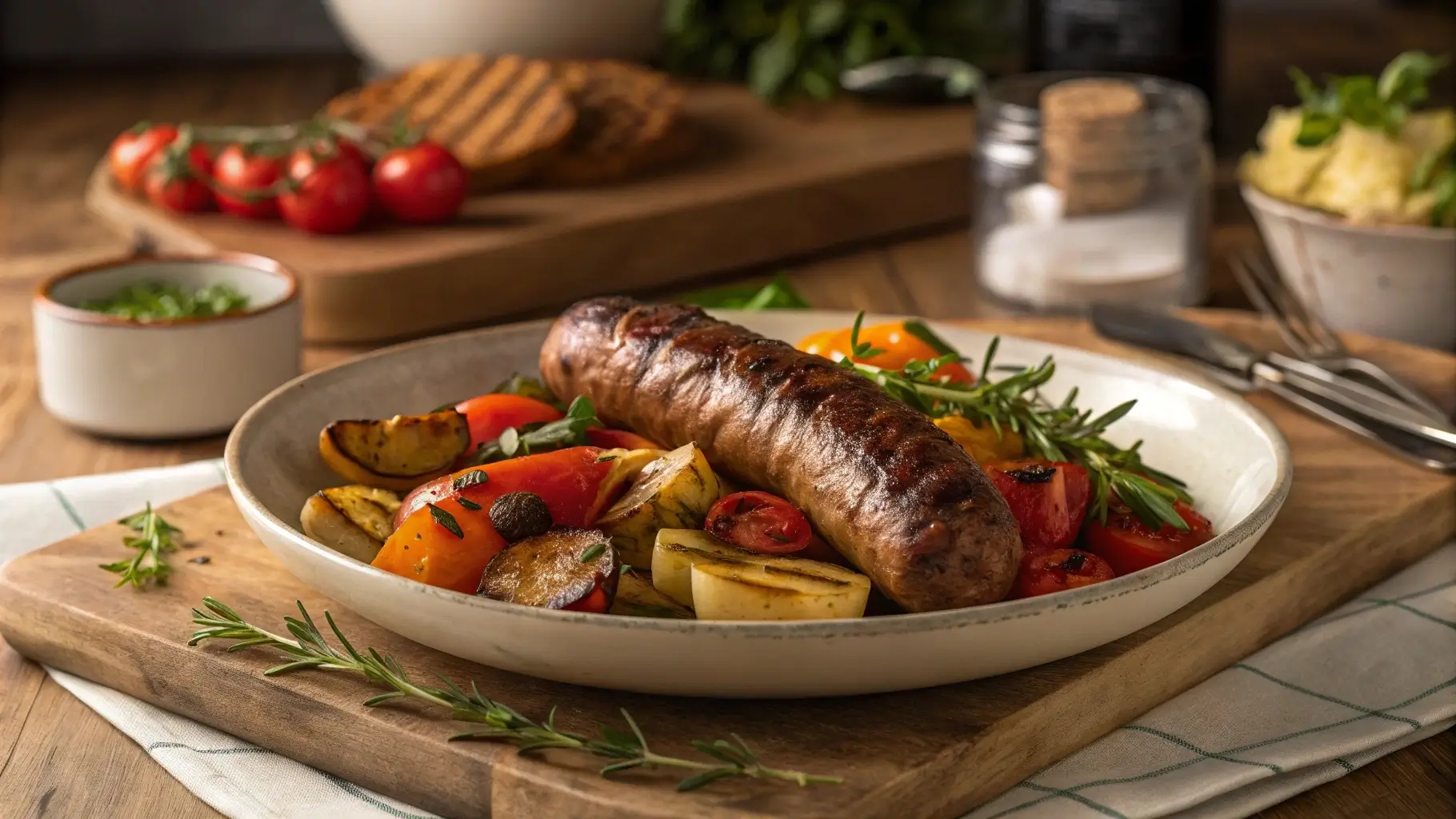Beef sausage has long been a staple in kitchens around the world, offering rich, savory flavors that elevate any dish. Whether you’re grilling it at a summer barbecue, adding it to a hearty breakfast casserole, or incorporating it into pasta, beef sausage delivers versatility and mouthwatering taste. In this comprehensive guide, we’ll explore everything you need to know, including the types of beef sausage, how to cook them, their nutritional benefits, and even common cooking mistakes to avoid. Let’s dive in and discover why this meaty delight is such a favorite.
Introduction to Beef Sausage
Beef sausage is more than just a protein option—it’s a flavorful addition that has earned its place in cuisines across the globe. But how did it become so popular, and what sets it apart from other sausages? Let’s take a closer look.
What is Beef Sausage and Why Is It Popular?
Beef sausage is a type of sausage made primarily from ground beef, blended with spices, seasonings, and sometimes fillers like breadcrumbs or rice. Its bold, savory flavor sets it apart from traditional pork sausage, making it a hit in recipes ranging from breakfast staples to gourmet dinners. One of its major appeals lies in its versatility—beef sausage can be fresh, cured, smoked, or spiced to complement nearly any dish.
Its popularity stems from its rich taste, high protein content, and the many ways it can be prepared. Whether grilled, fried, or simmered, beef sausage delivers robust flavors that are hard to resist. Plus, it’s available in various forms, such as Italian-style, chorizo, or summer sausage, to satisfy different palates.
A Brief History of Beef Sausage
Sausages have been around for centuries, dating back to ancient civilizations like the Greeks and Romans, who used them as a way to preserve meat. While pork sausage dominated many regions, beef sausage gained traction in areas where beef production was more prevalent, such as the Middle East, parts of Europe, and the Americas. Over time, regional recipes evolved, creating a wide variety of styles and flavors, from the smoky kielbasa of Poland to the spicy beef chorizo of Mexico.
Today, beef sausage is a global favorite, found in street food stalls, high-end restaurants, and home kitchens alike. It’s not just food—it’s tradition. 🌍
Stay tuned, because next, we’ll break down the different types of beef sausage and how they’re used in various cuisines. 🍴
Types of Beef Sausage You Should Know
Not all beef sausages are created equal, and their variety is part of what makes them so appealing. Whether you’re after smoky, spicy, or mild flavors, there’s a beef sausage for every occasion. Let’s explore the most popular types and how they’re used in different cuisines.
Fresh Beef Sausage Varieties
Fresh beef sausage is uncooked and typically seasoned with herbs, spices, and other flavorings. Some well-known varieties include:
- Italian Beef Sausage: A classic choice, usually seasoned with fennel, garlic, and red pepper flakes. This sausage is perfect for pasta dishes, casseroles, or grilled on its own.
- Breakfast Beef Sausage: Often seasoned with sage and a touch of sweetness, this sausage is a favorite for breakfast sandwiches and casseroles.
These fresh sausages require cooking before consumption and are often pan-fried, baked, or grilled for the best flavor.
Smoked and Cured Beef Sausages
Smoked and cured sausages are pre-cooked or preserved, making them ideal for quick meals and snacking. Examples include:
- Kielbasa: Originating from Poland, this sausage is smoky and flavorful, often paired with potatoes or cabbage.
- Beef Summer Sausage: This cured sausage is a picnic favorite and works well on charcuterie boards with cheese and crackers.
- Beef Chorizo: A Mexican staple with a spicy kick, it’s perfect for tacos, stews, or breakfast dishes.
Beef Sausage for Specific Cuisines
Beef sausage recipes vary greatly by region:
- Mexican Chorizo: Known for its bold and spicy flavors, it’s often used in tacos or scrambled eggs.
- German Bratwurst: While traditionally made with pork, beef versions exist and are delicious when grilled or simmered in beer.
- South African Boerewors: A coiled sausage made with ground beef, it’s flavored with coriander and vinegar and commonly cooked on a grill.
Want to try incorporating sausage into a unique meal? Check out this sausage and gnocchi soup recipe for a hearty dinner idea.
Nutritional Profile and Health Benefits of Beef Sausage
Beef sausage isn’t just a delicious addition to your meals—it’s also packed with important nutrients that can support your health when eaten in moderation. Here’s a closer look at its nutritional content and benefits.
Protein and Iron Content
Beef sausage is an excellent source of protein, providing the building blocks for muscle growth and repair. A typical serving contains around 12-15 grams of protein, depending on the brand and type. Additionally, it’s rich in iron, an essential mineral that supports red blood cell production and oxygen transport throughout the body. If you’re looking to boost your iron intake, adding beef sausage to your meals is a tasty way to do it.
The Role of Healthy Fats in Beef Sausage
Beef sausage contains fats, but not all fats are bad. Depending on the cut of beef used, you’ll find healthy fats like monounsaturated fat, which can help reduce inflammation and improve heart health. To make it a more balanced option, opt for leaner versions or grass-fed beef sausage, which tends to have higher omega-3 fatty acid content.
Balancing Nutritional Concerns
While beef sausage offers important nutrients, it’s also high in sodium and saturated fat, which can be a concern if consumed in large amounts. To balance this, pair it with nutrient-dense sides like vegetables or whole grains. Roasted broccoli or sautéed spinach can complement beef sausage perfectly while adding fiber and vitamins to the meal.
When eaten mindfully, beef sausage can be part of a healthy diet, providing both energy and flavor. Looking for ways to reduce sodium without sacrificing taste? You might want to try this creamy parmesan sausage soup for a healthier twist on comfort food. 🌟
How to Cook Beef Sausage: Methods and Techniques
Cooking beef sausage can be incredibly simple, but how you prepare it affects the texture, flavor, and overall outcome. With the right methods, you can unlock its full taste potential. Whether you like a crisp bite, juicy interior, or smoky flavor, here are the best cooking techniques to try.
Grilling and Pan-Frying Tips

Grilling and pan-frying are two of the most popular ways to cook beef sausage because they give you that mouthwatering, caramelized crust.
- Grilling: Preheat your grill to medium heat. Place the sausages directly on the grates and cook for about 10-12 minutes, turning frequently for even browning. The grill adds a smoky depth that works beautifully with spices in sausages like Italian or chorizo.
- Pan-Frying: Heat a bit of oil in a skillet over medium heat. Add the sausages and cook for 8-10 minutes, turning occasionally to brown all sides. For extra flavor, cook onions or peppers in the same pan to serve as a topping.
Both methods result in crispy skin and a juicy interior, making them ideal for serving with pasta, bread, or roasted vegetables.
Oven and Air Fryer Methods
For a hands-off approach, try baking beef sausage in the oven or using an air fryer:
- Oven: Preheat to 375°F (190°C). Place sausages on a baking sheet and cook for 20-25 minutes, flipping halfway. This method is great when cooking large batches or pairing them with roasted veggies.
- Air Fryer: Set to 375°F and cook sausages for 12-15 minutes, shaking the basket halfway. The air fryer creates crispy skin without the need for extra oil.
Boiling or Simmering for Juicy Sausages
Boiling is a great way to keep sausages moist and evenly cooked. Simmer them in water, broth, or beer for 10-15 minutes before pan-searing for extra flavor. Boiling ensures the sausages are cooked through and can help reduce fat content if desired.
Ready to combine this cooking knowledge into a delicious meal? Consider trying it in a beef sausage and kale soup for a cozy, healthy dinner.
Recipes Featuring Beef Sausage
When it comes to recipes, beef sausage can be the star of everything from breakfast dishes to hearty dinners. Its versatility means you can go savory, spicy, or even sweet depending on the seasonings and accompaniments. Let’s explore a few popular dishes that showcase its full flavor.
Classic Beef Sausage and Peppers Skillet

A beef sausage and peppers skillet is a one-pan wonder. It combines seared beef sausage slices with sautéed bell peppers, onions, and garlic in a light tomato sauce. Serve it over rice, pasta, or even with a warm crusty baguette.
Quick Tip: Use Italian beef sausage for extra herbs and spices. Squeeze a bit of lemon on top before serving to add brightness.
Beef Sausage Breakfast Casserole

Perfect for feeding a crowd, this casserole layers seasoned beef sausage with eggs, cheese, and diced potatoes or bread cubes. It’s baked until golden and bubbly, making it a go-to option for brunch or holiday breakfasts.
Customizable Add-ins: Add mushrooms, spinach, or roasted tomatoes for a more complex flavor.
Spicy Beef Sausage Pasta
If you love pasta with a kick, this one’s for you. Spicy beef chorizo or andouille sausage is the key to building bold flavors. Toss the sausage in a garlic and tomato-based sauce and mix with your favorite pasta—penne and rigatoni work best for soaking up the sauce.
Top with parmesan and fresh basil for a gourmet finish.
Grilled Beef Sausage with Mustard Glaze

Fire up the grill and glaze your sausages with a tangy mustard sauce during the final minutes of cooking. The result is caramelized, sticky goodness that’s hard to resist. Pair it with grilled veggies or a side of coleslaw for balance.
For even more dinner ideas, check out this ultimate guide to sausage-based meals. With a wide range of flavors and cooking styles, beef sausage will never let you down. 🌟
Buying and Storing Beef Sausage
Whether you’re picking up beef sausage at your local store or stocking up for meal prep, knowing how to select and store it properly is key. Let’s dive into tips on choosing high-quality sausage and keeping it fresh.
Choosing High-Quality Sausage: What to Look For
Not all beef sausages are made equally. When shopping, consider these key factors:
- Ingredient List: Choose sausages with simple, recognizable ingredients. Look for natural seasonings like garlic, black pepper, or fennel and avoid products with excessive fillers, nitrates, or preservatives.
- Meat-to-Fat Ratio: A good balance ensures your sausages stay juicy without being overly greasy. For a leaner option, go for grass-fed beef sausage or sausages labeled “low-fat.”
- Freshness Indicators: Fresh beef sausages should have a firm texture, bright color, and no off-putting smell. For pre-packaged varieties, check the “sell-by” or expiration date to ensure freshness.
Proper Storage Techniques for Fresh and Cooked Sausage
How you store your beef sausage directly impacts its shelf life and flavor:
- Fresh Sausage: Store raw sausages in the refrigerator at 40°F (4°C) or below. Keep them in their original packaging or transfer them to an airtight container.
- Cooked Sausage: After cooking, let them cool before refrigerating. Place leftovers in a sealed container and consume them within 3-4 days.
How Long Can You Store Beef Sausage?
For extended storage, freeze beef sausages. Raw sausages can be frozen for up to 3 months, while cooked sausages retain their quality for about 2 months. Wrap them tightly in plastic wrap or place them in freezer-safe bags to prevent freezer burn.
By following these tips, you’ll preserve the flavor and quality of your sausages, ensuring they’re always ready to add to your favorite recipes.
The Environmental and Ethical Considerations of Beef Sausage
Many consumers today are concerned about how their food choices impact the environment, and beef sausage is no exception. Understanding where your sausage comes from and how it’s produced can help you make sustainable and ethical choices.
Grass-Fed vs. Conventional Beef Sausage
One of the biggest differences lies in how the cattle are raised. Grass-fed beef comes from cows that graze naturally on grass, which generally leads to meat with higher omega-3s and antioxidants. It’s also considered more sustainable since grass-fed cattle require fewer resources compared to grain-fed ones.
While grass-fed beef sausage tends to be pricier, many people believe the health and environmental benefits justify the cost. Conventional beef sausage, on the other hand, may be more affordable but is often associated with higher environmental impact due to grain production and feedlot farming.
Sustainability in the Beef Industry
Supporting sustainable beef production is a growing concern for many consumers. To reduce your carbon footprint while enjoying beef sausage, consider purchasing from local farms or producers that follow sustainable practices, such as rotational grazing or organic farming methods. Additionally, some brands now offer “carbon-neutral” beef products, which offset emissions through conservation programs.
By making informed choices, you can enjoy the rich taste of beef sausage without compromising on your environmental values. 🌱
Common Mistakes to Avoid When Cooking Beef Sausage
Even the simplest recipes can go wrong if you’re not aware of a few key mistakes. Cooking beef sausage to perfection requires attention to temperature, timing, and technique. Here are the most common errors and how to avoid them.
Overcooking and Dry Sausage
Overcooked sausage can be dry and rubbery, ruining the juicy texture that makes it so delicious. To avoid this, cook beef sausage at medium heat and monitor its internal temperature. Use a meat thermometer to check for doneness—160°F (71°C) is the sweet spot for juicy, flavorful sausage.
Pro tip: Avoid cooking sausages over high heat for extended periods, as it can cause the casing to burst and moisture to escape.
Piercing the Sausage Casing
Many people think poking holes in the casing prevents sausage from bursting, but it actually allows juices to leak out, leaving the meat dry. Instead, cook the sausage gently and flip it often for even browning. The casing helps retain moisture and flavor, so keep it intact.
Failing to Rest the Sausage
Just like steak, beef sausage benefits from resting after cooking. Allowing the sausages to sit for 5 minutes lets the juices redistribute, ensuring a moist and tender bite. Cutting into them too early can cause those flavorful juices to spill out onto the plate.
By steering clear of these mistakes, you’ll consistently cook beef sausage that’s juicy, flavorful, and satisfying.
FAQs About Beef Sausage
Got questions about cooking and storing beef sausage? Let’s tackle some of the most common concerns to help you perfect your next meal.
1. Is Beef Sausage Healthier Than Pork Sausage?
It depends on your nutritional goals. Beef sausage is often higher in protein and iron compared to pork sausage. However, pork sausage typically has a higher fat content, which can make it juicier but less lean. Opt for lean beef sausage or grass-fed varieties for a healthier option.
2. Can You Freeze Beef Sausage?
Yes, you can freeze both raw and cooked beef sausage. Wrap it tightly in plastic wrap or place it in an airtight container to prevent freezer burn. For best results, use frozen sausage within 2-3 months.
3. What Spices Are Commonly Used in Beef Sausage?
Common spices include garlic, fennel seeds, black pepper, smoked paprika, and cayenne. Italian-style sausages may have oregano or basil, while Mexican chorizo includes cumin and chili powder for a spicy kick.
4. What’s the Best Way to Keep Sausage Juicy?
Cook sausage at medium heat and avoid piercing the casing. Additionally, resting it after cooking locks in moisture. If you’re pan-frying or grilling, adding a small splash of water or broth during the final minutes of cooking can help maintain its juiciness.
With these tips, you’re well-equipped to cook the perfect beef sausage dish every time! 🌟
